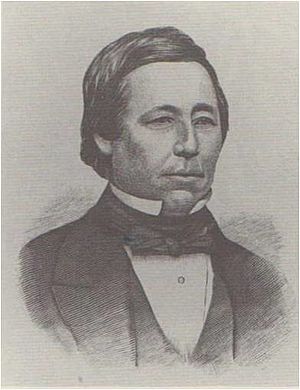Jonathan Eddy facts for kids
Quick facts for kids
Jonathan Eddy
|
|
|---|---|

Grandson of Colonel Jonathan Eddy, according to Wikimedia Commons
|
|
| Born | 1726 Norton, Massachusetts |
| Died | 1804 (aged 77–78) Maine |
| Buried | |
| Allegiance | |
| Years of service | 1755–1783 |
| Rank | |
| Battles/wars | French and Indian War Battle of Beausejour American Revolutionary War Battle of Fort Cumberland Battle of Machias (1777) |
Jonathan Eddy (born around 1726, died 1804) was a soldier who fought in two major wars. He first served the British in the French and Indian War. Later, he joined the American side during the American Revolution.
After the French and Indian War, Eddy moved to Nova Scotia. He became a "New England Planter," which meant he was a settler from New England who helped develop new lands. He even became a member of the local government, called the General Assembly of Nova Scotia.
When the American Revolution began, Eddy strongly supported the American fight for independence. He encouraged people in Nova Scotia to rebel against King George III and England. In 1776, he led an attempt to capture Fort Cumberland, but it failed. He had to go back to Massachusetts, where he was born. The next year, he helped defend Machias, Maine during another battle. After the war, in 1784, he started a new town called Eddington, Maine, where he lived until he died.
Early Life and the French and Indian War
Jonathan Eddy was born in Norton, Massachusetts, either in 1726 or 1727. In 1755, he joined the Massachusetts army, known as the militia. He took part in a successful battle led by Robert Monckton to capture Fort Beauséjour. This fort was located on the Isthmus of Chignecto during the French and Indian War.
By 1758, Eddy became a captain in the militia. He served again as a captain in 1759. His company was stationed at Fort Cumberland, which was the new name for Fort Beauséjour after it was captured. After the war ended, Eddy went back home to Norton. However, he soon returned to Cumberland in 1763 as a New England Planter. From 1770 to 1775, he served in the Nova Scotia House of Assembly. This was the local government for the area.
Jonathan Eddy and the American Revolution
When the American Revolutionary War started in Massachusetts in 1775, Jonathan Eddy openly supported the American side. The governor of Nova Scotia, Francis Legge, began to crack down on people who were speaking out against the British. Eddy saw this as a chance to act. He quickly went to his home area in Cumberland.
Eddy often traveled to meet with important American leaders. He spoke with Samuel Adams and the General Court of Massachusetts. He also met with General George Washington. He tried to get their support for a rebellion in Nova Scotia. Adams promised full support, including troops and weapons. Washington, however, was less eager and did not promise direct help. Still, Eddy managed to convince the Massachusetts government to provide some supplies. These included small arms like muskets.
In the summer of 1776, a new governor for Nova Scotia, Mariot Arbuthnot, took action. He ordered Colonel Joseph Goreham's soldiers, called the Royal Fencible Americans, to secure Fort Cumberland. Their job was to watch for any signs of an American invasion. Eddy knew he was being watched by people loyal to the British King. So, he fled to Massachusetts. There, he was made a full colonel in the Continental Army. He was given permission to create his own group of soldiers. Their goal was to invade Nova Scotia through Cumberland and Truro, and then move east towards Halifax.
The Attack on Fort Cumberland
Soon after General William Howe's army left Nova Scotia in 1776, Eddy made his move. He led a force of about 180 men. This group included American militiamen, Native Americans, and people from Nova Scotia. They marched towards Fort Cumberland.
They tried to storm the fort on November 13, 1776, but they were pushed back. They made two more attempts on November 22 and 23. However, on November 28, a British ship called HMS Vulture arrived. It sailed into the Bay of Fundy with British Royal Marines on board. These marines helped the soldiers already at the fort. Eddy and his group were scattered. They eventually gathered again near the Saint John River. Many of Eddy's supporters who lived near the fort had their homes and lands destroyed as punishment.
Eddy spent the rest of the war helping to manage the defense of Machias, Maine. This area was then part of Massachusetts. In 1801, he was given a piece of land in the Ohio Country for his service in the war. After the war, he moved to Stoughtonham. He also served in the Massachusetts government there. In 1784, he started a settlement on the eastern bank of the Penobscot River. This settlement grew into the town of Eddington, Maine, where he passed away in 1804.

